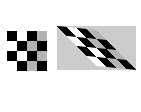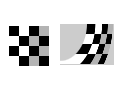

| Image Processing Toolbox |   |
Infer geometric transformation from control point pairs
Syntax
TFORM = cp2tform(input_points,base_points,transformtype)TFORM = cp2tform(CPSTRUCT,transformtype)TFORM = cp2tform(input_points,base_points,transformtype,parameter)TFORM = cp2tform(CPSTRUCT,transformtype,parameter)[TFORM,input_points,base_points] = cp2tform(CPSTRUCT,...)[TFORM,input_points,base_points,input_points_bad,base_points_bad] = cp2tform(...,'piecewise linear')
Description
TFORM = cp2tform(input_points,base_points,transformtype) takes pairs of control points and uses them to infer a spatial transformation. The function returns a TFORM structure containing the spatial transformation. input_points is an m-by-2 double matrix containing the x and y coordinates of control points in the image you want to transform. base_points is an m-by-2 double matrix containing the x and y coordinates of control points specified in the base image. The transformtype argument specifies the type of transformation you want to infer. For more information about supported types, see Transform Type.
TFORM = cp2tform(CPSTRUCT,transformtype) passes a CPSTRUCT structure that contains the control point matrices for the input and base images. The Control Point Selection Tool, cpselect, creates the CPSTRUCT.
[TFORM,input_points,base_points] = cp2tform(CPSTRUCT,...) returns the control points that were actually used in input_points, and base_points. Unmatched and predicted points are not used. For more information, see cpstruct2pairs.
Transform Type
transformtype specifies the type of spatial transformation to infer. This table lists all of the transformation types supported by cp2tform, in order of complexity. (See Algorithms for detailed information about each transform type.) The table includes the minimum number of control point pairs you must select for each type. The 'lwm' and 'polynomial' transform types can each take an optional, additional parameter. See the syntax descriptions that follow for details.
| Transformation Type |
Description |
Minimum Control Points |
Example |
| 'linear conformal' |
Use this transformation when shapes in the input image are unchanged, but the image is distorted by some combination of translation, rotation, and scaling. Straight lines remain straight, and parallel lines are still parallel. |
2 pairs |
 |
| 'affine' |
Use this transformation when shapes in the input image exhibit shearing. Straight lines remain straight, and parallel lines remain parallel, but rectangles become parallelograms. |
3 pairs |
 |
| 'projective' |
Use this transformation when the scene appears "tilted." Straight lines remain straight, but parallel lines converge toward "vanishing points" which may or may not fall within the image. |
4 pairs |
 |
| 'polynomial' |
Use this transformation when objects in the image are curved. The higher the order of the polynomial, the better the fit, but the result can contain more curves than the base image. |
6 pairs (order 2) 10 pairs (order 3) 16 pairs (order 4) |
 |
| 'piecewise linear' |
Use this transformation when parts of the image appear distorted differently. |
4 pairs |
 |
| 'lwm' |
Use this transformation (local weighted mean), when the distortion varies locally and piecewise linear is not sufficient. |
6 pairs (12 pairs recommended) |
 |
TFORM = cp2tform(input_points,base_points,'polynomial',ORDER)
TFORM = cp2tform(CPSTRUCT,'polynomial',order)
When 'polynomial' is the transform type, you can optionally specify the order of the polynomial to use. order can be the scalar value 2, 3, or 4. If you omit order, it defaults to 3.
TFORM = cp2tform(input_points,base_points,'lwm',N)
TFORM = cp2tform(CPSTRUCT,'lwm',N)
When 'lwm' is the transform type, you can optionally specify the number of points, N, used to infer each polynomial. The radius of influence extends out to the furthest control point used to infer that polynomial. The N closest points are used to infer a polynomial of order 2 for each control point pair. If you omit N, it defaults to 12. N can be as small as 6, but making N small risks generating ill-conditioned polynomials.
[TFORM,input_points,base_points,input_points_bad,base_points_bad]=
cp2tform(input_points,base_points,'piecewise linear')
[TFORM,input_points,base_points,input_points_bad,base_points_bad]=
cp2tform(CPSTRUCT,'piecewise linear')
When 'piecewise linear' is the transform type, cp2tform can optionally return the control points that were actually used in input_points and base_points, and return two arrays, input_points_bad and base_points_bad, that contain control points that were eliminated because they were middle vertices of degenerate fold-over triangles.
Algorithms
cp2tform uses the following general procedure:
transformtype.
TFORM structure containing spatial transformation.
The procedure varies depending on the transformtype.
Linear Conformal
Linear conformal transformations may include a rotation, a scaling, and a translation. Shapes and angles are preserved. Parallel lines remain parallel. Straight lines remain straight.
The coefficients of the inverse mapping are stored in t_lc.tdata.Tinv.
Since linear conformal transformations are a subset of affine transformations, t_lc.forward_fcn is @affine_fwd and t_lc.inverse_fcn is @affine_inv.
At least two control-point pairs are needed to solve for the four unknown coefficients.
Affine
In an affine transformation, the x and y dimensions can be scaled or sheared independently and there may be a translation. Parallel lines remain parallel. Straight lines remain straight. Linear conformal transformations are a subset of affine transformations.
Tinv is a 3-by-2 matrix. Solve for the 6 elements of Tinv.
The coefficients of the inverse mapping are stored in t_affine.tdata.Tinv.
At least 3 control-point pairs are needed to solve for the 6 unknown coefficients.
Projective
In a projective transformation, quadrilaterals map to quadrilaterals. Straight lines remain straight. Affine transformations are a subset of projective transformations.
For a projective transformation:
Solve for the 9 elements of Tinv.
The coefficients of the inverse mapping are stored in t_proj.tdata.Tinv.
At least 4 control-point pairs are needed to solve for the 9 unknown coefficients.
Polynomial
In a polynomial transformation, polynomial functions of x and y determine the mapping.
Piecewise Linear
In a piecewise linear transformation, linear (affine) transformations are applied separately to each triangular region of the image [1].
| Note At least 4 control-point pairs are needed. Four pairs result in two triangles with distinct mappings. |
Local Weighted Mean
For each control point in base_points:
N closest control points.
N points and their corresponding points in input_points to infer a second order polynomial.
| Note At least 6 control-point pairs are needed to solve for the second-order polynomial. Ill-conditioned polynomials may result if too few pairs are used. |
Example
I = checkerboard; J = imrotate(I,30); base_points = [11 11; 41 71]; input_points = [14 44; 70 81]; cpselect(J,I,input_points,base_points); t = cp2tform(input_points,base_points,'linear conformal');
ss = t.tdata.Tinv(2,1); % ss = scale * sin(angle) sc = t.tdata.Tinv(1,1); % sc = scale * cos(angle) angle = atan2(ss,sc)*180/pi scale = sqrt(ss*ss + sc*sc)
See Also
cpcorr, cpselect, cpstruct2pairs, imtransform
References
[1] Ardeshir Goshtasby, Piecewise linear mapping functions for image registration, Pattern Recognition, Vol 19, pp. 459-466, 1986.
[2] Ardeshir Goshtasby, Image registration by local approximation methods, Image and Vision Computing, Vol 6, p. 255-261, 1988.
 | corr2 | cpcorr |  |